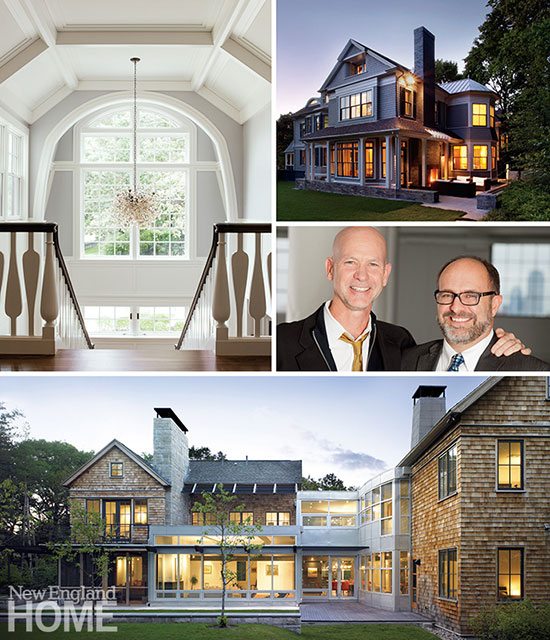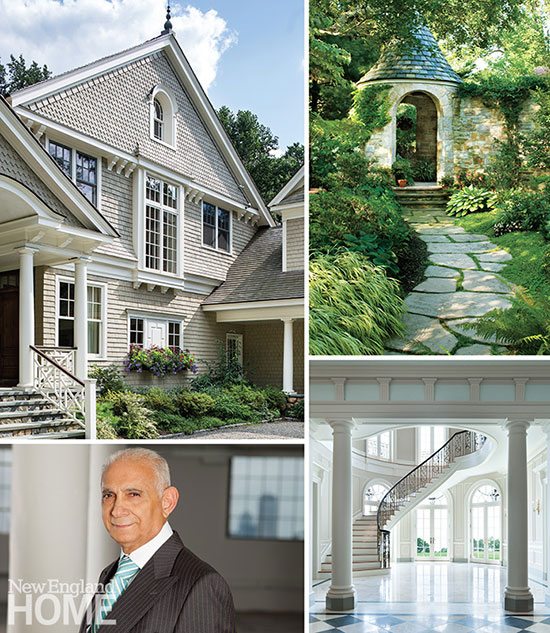2014 New England Design Hall of Fame
October 29, 2014
Text by Erin Marvin Photography by Bruce Rogovin

Many of the inductees into our eighth annual New England Design Hall of Fame took a circuitous route to the design industry, first sampling fashion, medicine, social work, and other careers before finding their true calling in architecture and interior design. The defining thread linking them all is talent, and we are thrilled to announce that Douglas Dick, Treffle LaFleche, Christina Oliver, Dinyar Wadia, Jim Gauthier, Susan Stacy, and Rosemary Porto will be joining the gifted ranks of architects, interior designers, landscape architects, and specialty designers who came before them.
As in previous years, it was no easy feat for the judges tasked with determining the new inductees. Carefully reviewing the dozens of nominations from across the industry, each judge was asked to consider a number of criteria when making his or her selections: number of years spent in the design trade, community involvement, mentorship of the next generation, other industry recognition, and, perhaps most important, quality of work. The committee charged with selecting the 2014 class consisted of Boston Architectural College president emeritus (and brand-new member of the board of the Boston Redevelopment Authority) Ted Landsmark, New England Home editor-in-chief Kyle Hoepner, and three previous Hall of Fame inductees: architect David Hacin, interior designer Nancy Serafini, and landscape architect Jeff Hodgson.
Boston’s State Room will once again be the hot destination for design aficionados and members of the trade on Wednesday, November 5, as the new inductees are welcomed in high style with a gala dinner and awards ceremony.
That night will also be the beginning of a new, yearlong program of research into and programs about New England’s residential design history, to culminate in one or more special features in this magazine and a presentation at next year’s gala. Stay tuned for more details.
In the meantime, please join us in congratulating this year’s New England Design Hall of Fame inductees!
Jim Gauthier and Susan Stacy
Interior Design

We can thank Christopher Drake and the late Lee Bierly, another talented design duo in the New England Design Hall of Fame, for bringing together Jim Gauthier and Susan Stacy.
After all, it was while working at Bierly-Drake that Gauthier and Stacy first met—even after both earning fine-arts degrees at the same college—and where they formed a lasting friendship. Similar design sensibilities and a shared work ethic led them to start their own firm, Gauthier-Stacy, in 1996. “Jim and I are exactly on the same page in so many ways, and couldn’t be more polar opposites in others,” says Stacy. “I think that’s what makes us successful.”
Gauthier is outgoing where Stacy is reserved, but when it comes to interior design both exude a creative energy and a sense of fun. Their work is classic and timeless, not driven by trends—but also not without spontaneity. “We like to have a little whimsy or something charming or unexpected in our work,” says Gauthier.
“It’s about creating environments that people will thoroughly enjoy and create incredible memories in,” adds Stacy.
Close attention is paid to interior architectural details, the scale of a room, and the careful interpretation of clients’ needs. They share a similar drive for seeing projects through to the end, as well as down to the very last detail: carefully chosen artwork over the mantel, hand-picked silverware in a kitchen drawer, custom beach chairs arranged just so.
An impressive roster of repeat clients around the U.S.—from New England to California, Florida to Texas, and across the Midwest—is a true testament to the pair’s success. Their work has been published in Veranda, House Beautiful, New England Home, and other publications. One of the firm’s most notable (and favorite) projects was the Great Harbor Yacht Club on Nantucket. “We worked so hard and were so passionate about it, it’s kind of our baby,” admits Gauthier. “We still go out once a year and go through the club to make sure it looks like the day we left it.” •
Treffle LaFleche and Douglas Dick
Architecture

LDa Architecture & Interiors came to life in Treffle “Treff” LaFleche’s basement back in 1992. LaFleche and Douglas Dick, who had worked together at Boston-based Perry Dean Rogers, grabbed hold of their deep friendship, a similar interest in architectural diversity, and a strong working relationship, and took a leap of faith to open their own firm.
Now working out of their Cambridge, Massachusetts, office, the pair has had resounding success. Rather than imposing a particular design style from one project to the next, LDa’s work reflects the unique and interesting lives of the clients. “We’re both fascinated by how architecture can really be quite different based on the climate and culture that is prevalent in any given location, and, of course, who the dwellers are,” explains LaFleche.
Although renowned for their high-end architecture—which has garnered recognition from the Institute of Classical Architecture & Art and the American Institute of Architects New England—the pair takes this same thoughtful approach to their work for nonprofits and housing authorities. Notable projects include energy-efficient affordable-housing units in Northampton, Massachusetts, and a camp of off-the-grid cabins for the Appalachian Mountain Club. “Part of the richness of architecture is not just about the universities and corporations and upper-class people who can afford to build buildings,” says Dick. “It’s also for people who can’t afford to build for themselves. We try to do something that, although very cost effective, still brings out the same idea that we’re trying to build a unique place for people to have a sense of community and a sense of home.”
Dick and LaFleche pass these same principles—along with a sense of stewardship, sustainability, and historic preservation—to the next generation through an internship program at the firm.
“Our work is always a labor of love,” says LaFleche. “We never see it as work; we just see it as fulfilling our passion for understanding the world around us and seeing if we can improve it a little bit.” •
Christina Oliver
Interior Design

Although she was born into a family of architects, designers, and draftsmen, Christina Oliver did not discover a passion for interior design until after a sixteen-year career as a social worker. While Oliver was contemplating a higher degree in the mental health field, a Myers-Briggs test revealed a keen sense of space she hadn’t previously given much thought to. Once she did, she never looked back.
She earned her certificate in interior design from Boston Architectural College in 1990, and opened Oliver Interiors in 1991.
It turns out that social work isn’t so far removed from interior design: Oliver’s skill for listening to what clients really want and then translating that into personal spaces factors heavily into her success.
Giving back to the community remains a strong tenet of her work ethic; she places an emphasis on hiring interns, and often works for such nonprofits as Rosie’s Place and the Devon Nicole House at Children’s Hospital Boston. “With all the help and mentoring that I received during the time I was trying to develop my own career, I felt that I needed to give back,” says Oliver. “I work with a lot of people who have a lot of resources, and it’s important to me to do work for people who don’t have those same resources.”
As past president of ASID New England and current president of the Massachusetts Interior Design Coalition, Oliver has been dedicated to pushing through legislation allowing interior designers to bid on state projects separately from architects and engineers. After years of hard work by Oliver and other designers (including fellow New England Design Hall of Fame inductee Lisa Bonneville and Mount Ida College professor Rose Botti-Salitsky), the bill has finally been signed.
Thanks to the dedication of Oliver and others, interior designers can bid on state projects beginning November 19, 2014. •
Rosemary Porto
Specialty Design

New England Design Hall of Fame 2014 inductee…multiple BAGB Prism Award winner…director-at-large for the American Society of Interior Designers New England…past president of the New England Chapter of the International Furnishings and Design Association…active in the Boston Society of Architects’ Women in Design committee…frequently published in leading shelter magazines such as Architectural Digest, Better Homes & Gardens’s Kitchen and Bath Ideas, and New England Home…
There are many ways to describe Rosemary Porto, this year’s honoree for specialty design, but she’d rather you didn’t call her a kitchen designer. “I’m an interior designer specializing in contemporary kitchens,” she explains.
Those who have seen her work just call her talented, appreciating her intrinsic gift for humanizing contemporary kitchens. Porto’s flair for understanding the organic nature of a space and designing for individual users—coupled with a dose of creativity and careful editing—is the perfect recipe for some of New England’s most sought-after spaces. In fact, fellow New England Design Hall of Fame inductees such as Mark Hutker, Morgan Wheelock, and Douglas Reed have turned to Porto for help with designing the kitchen in their own homes.
Porto wasn’t always found in the kitchen, however: She spent thirteen years in the fashion business before taking courses in interior design and discovering a true love of designing rooms and furniture as well as collaborating with architects. Today she is the senior designer and sales manager for Poggenpohl Boston, where she says she has found her true passion. “When I first opened Poggenpohl, people would look at our cabinets like we were the Jetsons,” she recalls. “Now people get it; I think people have more guts about doing contemporary design now.”
A major hallmark of Porto’s work is her ability to listen to her clients and translate their vision into custom spaces that work beautifully. “One of the things good designers do for clients,” she says, “is hold their hand when they take a leap of faith, and give them confidence to express themselves.” •
Dinyar Wadia
Architecture

Growing up in Bombay, India, Dinyar Wadia was surrounded by beauty: when he was a child, the capital city was the jewel of the British Empire, and he found inspiration in the prepossessing buildings of his native home. He loved to draw, and the city provided no small collection of awe-inspiring landmarks to capture on paper. Five years studying architecture at the Byzantine-inspired Maharaja Sayajirao University, followed by graduate school at Columbia University, instilled in him a keen sense of detail and proportion still evident in his work today.
Founded in 1975, Wadia Associates has pioneered the New Classicist vernacular in Connecticut and beyond. The firm’s work pays homage to traditional styles, but uses modern proportions and scale, with simplified details and thoughtful surprises. Although many of their projects are influenced by styles of the past, such as Shaker, English Tudor, French Country, Queen Anne, Arts and Crafts, and others, these are not your grandmothers’ houses. You won’t find dark, heavy interiors; instead, homes feel fresh and bright. “Everything we do is understated and elegant,” says Wadia.
The architect is quick to stress that any good design is not complete without equally thoughtful attention to a home’s surrounding landscape. “Good design is a house woven into the site,” he explains. “A house without a landscape is a house without a soul.”
While much of the firm’s work resides in Connecticut and other New England states, Wadia’s architectural contributions span the country and the world, with designs in Palm Beach, Sri Lanka, New Delhi, and China. “Every home we design is tailored to a particular client’s needs,” he says. “Our goal is to make our clients happy when they come home.”
The firm’s work has been showcased in numerous publications, including Greenwich Magazine, East Coast Home & Design, DOM & Interiors, Luxe Interiors & Design, New England Home Connecticut, At Home, and House Beautiful. The firm’s 2007 monograph, New Classicists: Wadia Associates, was written by Wadia with a foreword by Prince Charles (HRH The Prince of Wales). •
Share
![NEH-Logo_Black[1] NEH-Logo_Black[1]](https://b2915716.smushcdn.com/2915716/wp-content/uploads/2022/08/NEH-Logo_Black1-300x162.jpg?lossy=1&strip=1&webp=1)









You must be logged in to post a comment.